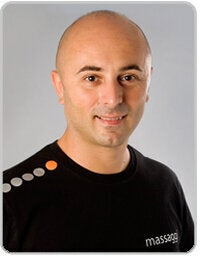If you have a short-circuit at home, do you call a plumber or an electrician? Exactly right, an electrician.
When it comes to bodies, different systems require different specialties: the central nervous system is what controls all body functions and it needs careful calibrating.
Bodies respond well to massage and other forms of hands-on work. I recently came across the Emmett Technique and was impressed with the results.
What is the Emmett Technique?
The Emmett Technique has been available as a complementary therapy for pain and injuries in the UK since 2007. It works with specific activation points called Emmett points which are not the same as shiatsu or other trigger points. The technique uses light pressure and very precise application.
The Emmett Technique can be used alongside other modalities like sports massage or as a standalone session.
The treatment
I met Ben at Massaggi, a massage company in London. Ben started the treatment testing my muscles and balance and found that the reason I was "wobbly" on my feet was because the muscles needed resetting to normal. In other words, just like you do with your computer, we all need to press the "reset" button to improve our performance.
Bodies, says Ben, are like expensive sports cars that need maintenance and our brains are the main computers. When the operating system needs an upgrade you need to press reset and go back to a state of balance.
Ben worked on my feet and lower legs as feet are what keep us grounded: he did refer to the analogy of our feet being like the wheels of a bicycle. You need to make sure the wheels are stable if you want to go the distance. It all made perfect sense to me.
Ben used light to medium pressure and energy work; as he was working on my legs I could feel they were automatically readjusting to a state of balance. In other words, I could feel the muscles relaxing and lengthening gently without much manipulation.
We tested the muscles again and Ben asked me to walk and feed back the sensation of my feet making contact with the floor. I did feel more stable on my feet. He then moved on to work on my core - I have scoliosis and lordosis which are two types of curvature of the spine. One leg is stronger than the other and my hips have an inherent rotation. Working against this inner twists is a challenge but I noticed that the treatment freed up the restrictions in my muscles, particularly in my hips and even in my neck, which was not treated during the session.
Homeostasis is the state of balance that our bodies are designed to be in at all times. Bad posture and injuries interfere with the state of homeostasis.
The treatment ultimately made me feel more aware about how my body feels and reminded me of how the body is supposed to feel: flexible, pain-free and moving naturally without effort.
When your body short-circuits, it's better to call a bodywork electrician.

Ben Pianese of Massaggi practises in Central London: Massaggi London
He developed the Body Optimization and Recalibration or ORB™, a bespoke technique to recalibrate the neuromuscular system. ORB combines the Emmett Technique with Neurostructural Integration technique for pain relief and rebalancing.